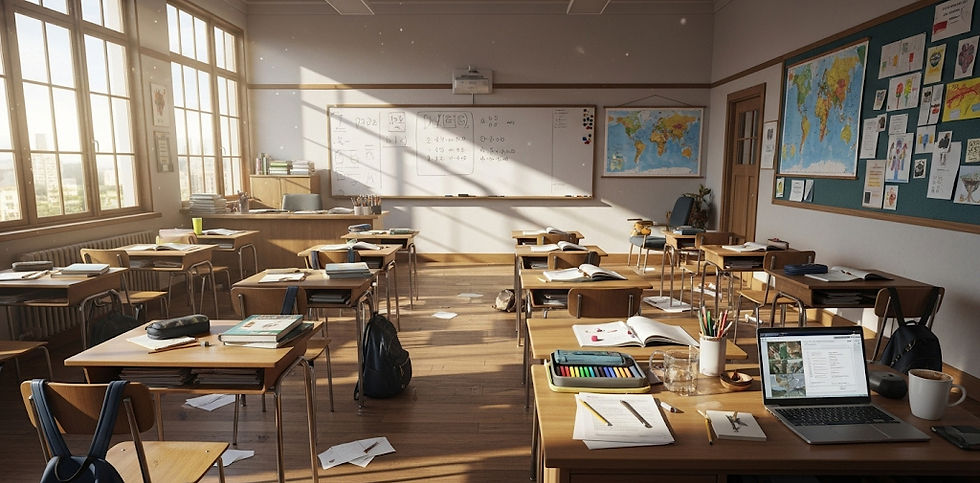Importance of Cleanliness in Schools: Creating a Healthy and Productive Learning Environment
- Kevin Sibille
- Aug 11
- 4 min read

Cleanliness in schools is not just about keeping things tidy—it’s about creating a safe, healthy, and motivating place for students to learn and grow. From classrooms and restrooms to cafeterias and playgrounds, every area plays a role in students’ overall well-being. One of the most effective ways to ensure consistent hygiene is by following a school cleaning checklist. This checklist acts as a guide for staff, ensuring that no area is overlooked, and cleanliness standards remain high every day.
In this blog, we’ll explore why cleanliness in schools is so important, how it impacts health and learning, and how both the school community and professional cleaning services can work together to keep schools in top condition.
Health Benefits of Clean Schools
Prevention of Illness
Schools are high-traffic areas where germs spread quickly. Shared desks, doorknobs, and learning materials can carry bacteria and viruses that lead to illnesses like colds, flu, and stomach bugs. Regular cleaning and disinfecting significantly reduce the spread of these germs, keeping students and teachers healthier.
Reduction in Absenteeism
Healthier students and staff mean fewer sick days. When absenteeism drops, students don’t miss out on lessons, and teachers can maintain a steady teaching schedule. This continuity helps improve overall academic performance.
Better Air Quality
Dust, mold, and allergens can affect indoor air quality, causing respiratory problems, headaches, and fatigue. Regular cleaning, vacuuming with HEPA filters, and proper ventilation improve air quality, making it easier for students to focus and learn.
Impact on Academic Performance
A clean school environment supports better learning in several ways:
Improved Concentration: Cluttered or dirty spaces can distract students. A clean, organized classroom allows them to focus on the task at hand.
Positive Mindset: Students tend to feel more motivated and energetic in clean surroundings.
Encouraging Engagement: A pleasant environment encourages active participation, collaboration, and creativity.
Simply put, a tidy school isn’t just visually appealing—it actively supports better learning outcomes.
Psychological and Social Benefits
Cleanliness goes beyond physical health—it also impacts emotional well-being and social behavior.
Boosts School Pride: When students see their school is well-maintained, they develop a sense of pride and respect for their environment.
Promotes Respect for Shared Spaces: Clean surroundings encourage students to be more mindful about littering or damaging property.
Welcoming Atmosphere: Parents, visitors, and new students feel more comfortable and confident in a school that looks well-cared-for.
Role of Cleanliness in Discipline and Character Building
Maintaining cleanliness teaches students valuable life lessons:
Responsibility: Encouraging students to tidy their desks, clean up after activities, and follow hygiene rules instills responsibility.
Teamwork: Group activities like campus clean-up days promote teamwork and cooperation.
Healthy Habits: Learning proper hygiene practices—washing hands, disposing of waste properly—becomes second nature, benefiting them beyond school life.
Areas in Schools That Require Special Attention
A school cleaning checklist should cover all essential areas to make sure nothing is overlooked.
1.Classrooms
Clean desks, chairs, and boards daily.
Disinfect high-touch surfaces like light switches and door handles.
Sweep and mop floors regularly.
2.Restrooms
Maintain sanitation supplies like soap, paper towels, and hand dryers.
Clean toilets, sinks, and mirrors multiple times a day.
Disinfect handles and locks to prevent germ spread.
3.Cafeteria & Kitchen
Ensure food preparation areas meet hygiene standards.
Sanitize tables and trays after every meal.
Regularly clean refrigerators, ovens, and storage areas.
4.Playgrounds
Remove litter and debris daily.
Check for broken equipment or unsafe surfaces.
Empty trash bins regularly.
5.Libraries, Labs, and Computer Rooms
Dust shelves, computers, and lab equipment.
Sanitize keyboards, mice, and shared tools.
Keep floors and furniture free from clutter.
Involving the School Community
Keeping a school clean is a shared responsibility. When the whole community is involved, cleanliness becomes part of the culture.
Teachers:
Encourage students to clean their work areas.
Integrate hygiene awareness into lessons.
Lead by example through tidy classrooms.
Students:
Participate in awareness campaigns and cleaning drives.
Follow hygiene rules like proper handwashing.
Take pride in keeping their surroundings clean.
Parents:
Reinforce cleanliness and hygiene habits at home.
Provide children with personal hygiene items like hand sanitizers.
Support school initiatives related to cleanliness.
Professional Cleaning and Maintenance
While daily cleaning can be managed by school staff, professional cleaning services are essential for maintaining deeper hygiene standards.
Why Schools Should Hire Professionals?
Expertise: Trained cleaners know how to sanitize different surfaces effectively.
Equipment: Professional teams use advanced tools and eco-friendly products.
Efficiency: They can clean large areas in less time without disrupting school operations.
Regular Deep Cleaning:
Scheduling periodic deep cleaning—especially before a new school term—helps eliminate built-up dirt, germs, and allergens. This is especially important in restrooms, cafeterias, and high-traffic areas.
Using a School Cleaning Checklist Effectively
A school cleaning checklist isn’t just a formality—it’s a powerful tool to maintain consistent hygiene.
Benefits of a School Cleaning Checklist:
Ensures no area is missed during daily cleaning.
Standardizes cleaning routines across all staff members.
Helps track maintenance needs and supply shortages.
Can be customized for daily, weekly, and monthly tasks.
Eco-Friendly Cleaning in Schools
Cleanliness should not come at the cost of the environment. Many schools now opt for eco-friendly cleaning practices:
Using biodegradable cleaning agents.
Installing recycling bins to reduce waste.
Encouraging reusable lunch containers and water bottles.
Eco-friendly cleaning keeps students safe from harsh chemicals and promotes environmental responsibility.
Conclusion
The importance of cleanliness in schools cannot be overstated—it directly affects students’ health, academic performance, emotional well-being, and personal growth. By following a school cleaning checklist, schools can ensure that every corner, from classrooms to playgrounds, remains clean, safe, and welcoming.
A clean school doesn’t just protect against illness—it fosters discipline, pride, and a positive learning atmosphere. It’s a team effort, involving teachers, students, parents, and professional cleaning services working hand in hand.
When schools make cleanliness a priority, they invest in the success and happiness of every student who walks through their doors.

Comments